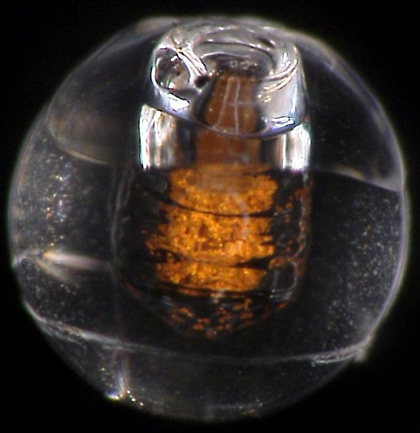Researchers at the fusion institutes NIFS in Japan, CIEMAT in Spain and IPP-Greifswald in Germany have joined forces to learn how performance-reducing impurities diffuse through the hot, charged gas (plasma) in their fusion devices. By shooting tiny pellets with contaminants into the plasma at predetermined locations, they hope to study how these substances migrate and learn whether the turbulent plasma can be made to push them out towards its edge.
Sharing knowledge
Originally, the TESPELs or Tracer Encapsulated Solid PELlets were produced by NIFS for use in their stellarator LHD in Toki, Japan. Over the past years, NIFS researchers have transferred their know-how to colleagues at the Spanish fusion institute CIEMAT for use in the European sister stellarators TJ-II in Madrid and W7-X in Greifswald, Germany. Ten such 0.7 mm pellets crafted in Madrid have now been successfully tested in LHD; each contained only micrograms of impurities such as titanium, iron, nickel, copper and tungsten, enough to make up a few percent of the total plasma mass.
At the Wendelstein 7-X stellarator in Greifswald, fusion researcher René Bussiahn is thrilled to hear about the pellet production at CIEMAT and their successful tests at NIFS. “During the last W7-X campaign, TESPEL injections have shown to be a very reliable way to deposit impurities right where we want them: deep in the core plasma. They’re an excellent tool to study the migration and build-up of these impurities.”

Watchmaker’s tools
“Making these pellets takes a steady hand”, explains Ireland-born physicist Kieran McCarthy at CIEMAT. When NIFS researcher Naoki Tamura contacted CIEMAT to install a TESPEL injector on the local TJ-II stellarator, McCarthy eagerly took up the gauntlet. Or watchmaker’s tools, to be more precise: “It’s all done by hand under a microscope”, says McCarthy: “from forming the polystyrene balls in a mold half a millimeter wide, to drilling out an inner cavity with a watchmaker’s drill, packing in the contaminant powder with a toothpick and sealing the pellet with a 0.3 mm lid.”
The researchers at NIFS, CIEMAT and IPP believe that the successful injection of CIEMAT-made pellets at LHD is a crucial step in bolstering this inter-continental collaboration in times of COVID-19. As a next logical step, CIEMAT will focus on production for the German stellarator W7-X, the biggest fusion experiment of its kind. “It takes about an hour and quite a bit of craftsmanship to create one single pellet, so with the new TESPEL fabrication lab at CIEMAT we can significantly increase production”, adds René Bussiahn.
For the upcoming W7-X campaign, 100 – 200 TESPELs are foreseen to be injected. In the future, the tiny tracer pellets produced at both CIEMAT and NIFS might even be exported to other fusion experiments worldwide, helping solve the big question of how contaminants migrate through fusion plasmas.

